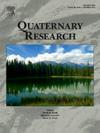Updated chronology for Peoria Silt (loess) accumulation in Illinois and western Indiana from radiocarbon dating of terrestrial gastropod shells
IF 1.7
3区 地球科学
Q3 GEOGRAPHY, PHYSICAL
引用次数: 0
Abstract
Based on calibrated radiocarbon ages of terrestrial gastropod shells (Succineidae, Discus, Stenotrema, Webbhelix), the chronology of Peoria Silt (loess) deposition in the Central Lowlands is updated. These taxa provide reliable ages (within ~0.2 ka), based on historical shell dating, shell-organic age comparisons, and stratigraphic consistency. A compilation of 53 new and 36 published Peoria Silt shell ages (calibrated), from 12 localities, date from 30.0 to 17.4 ka. Proximal (fossiliferous) loess from 10 sections had mean loess accumulation rates of 0.6–2.2 mm/yr. Study sites along the upper Mississippi, Illinois, to mid-Mississippi, and Ohio-Wabash Valleys suggest Peoria loess accumulated from ~27 to 15 ka, ~29 to 18 ka, and ~30 to 18 ka, respectively. The cessation age for Peoria Silt, based on surface extrapolations, is ~1–6 ka earlier than some prior Illinois estimates, even assuming slower loess accumulation in the modern solum. Younger loess in northwestern Illinois likely reflects, in part, Superior and Des Moines Lobe glacial-meltwater sediment, and Iowan Erosion Surface inputs to the upper Mississippi Valley, after the Lake Michigan Lobe receded. Furthermore, stronger winds, drier conditions, and reduced vegetation cover in valley deflation areas may have favored higher accumulation rates and later loess deposition in northwestern relative to southeastern areas.根据陆生腹足类贝壳的放射性碳年代测定,更新伊利诺伊州和印第安纳州西部的皮奥里亚淤泥(黄土)堆积年代学
根据陆生腹足类贝壳(Succineidae、Discus、Stenotrema、Webbhelix)的校准放射性碳年龄,更新了中部低地皮奥利亚淤泥(黄土)沉积的年代学。根据历史贝壳测年、贝壳-有机年龄比较和地层一致性,这些分类群提供了可靠的年龄(约 0.2 ka 以内)。汇编了来自 12 个地点的 53 个新的和 36 个已公布的皮奥里亚淤泥质贝壳年龄(校准),其年代为 30.0 至 17.4 ka。来自 10 个地段的近端(含化石)黄土的平均黄土堆积速率为 0.6-2.2 毫米/年。沿密西西比河上游、伊利诺伊州、密西西比河中游和俄亥俄-瓦巴什山谷的研究地点表明,皮奥里亚黄土分别在 ~27 至 15 ka、 ~29 至 18 ka 和 ~30 至 18 ka 期间堆积。根据地表推断,即使假定现代地层的黄土堆积速度较慢,皮奥里亚淤泥的终止年龄也比伊利诺伊州之前的一些估计早约 1-6 ka。伊利诺伊州西北部较年轻的黄土可能部分反映了密歇根湖裂片消退后,苏必利尔湖和得梅因湖裂片冰川融水沉积物以及密西西比河上游的伊奥瓦侵蚀表层输入。此外,较强的风力、较干燥的条件以及河谷放缩地区植被覆盖的减少,可能有利于西北部地区相对于东南部地区更高的堆积率和更晚的黄土沉积。
本文章由计算机程序翻译,如有差异,请以英文原文为准。
求助全文
约1分钟内获得全文
求助全文
来源期刊

Quaternary Research
地学-地球科学综合
CiteScore
4.70
自引率
8.70%
发文量
57
审稿时长
3 months
期刊介绍:
Quaternary Research is an international journal devoted to the advancement of the interdisciplinary understanding of the Quaternary Period. We aim to publish articles of broad interest with relevance to more than one discipline, and that constitute a significant new contribution to Quaternary science. The journal’s scope is global, building on its nearly 50-year history in advancing the understanding of earth and human history through interdisciplinary study of the last 2.6 million years.
 求助内容:
求助内容: 应助结果提醒方式:
应助结果提醒方式:


